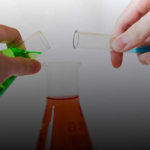Section 1
Preview this deck
Plum Pudding Model
Front
Active users
0
All-time users
0
Favorites
0
Last updated
4 years ago
Date created
Mar 14, 2020
Cards (57)
Section 1
(50 cards)
Plum Pudding Model
negative charges on atoms were called electrons that were sprinkld throughout the poistively charged atom like chocolate chips in cookie dough
Aufbau Principle
when building up the electron configuration of an atom, electrons are placed in orbitals, subshells, and shells in order of increasing energy.
Incoming energy (photon)=
ioniyation energy + kinetic energy (of an electron)
What are electrons repelled by?
electrons are repelled by other electrons in an atom
The faster an ejected electron is going...
...the more kinetic energy it has and the further it was from the nucleus originally
Empirical formula
represents the simplest ratio of one element to another in a compound (ie, CH₂O)
Atomic Radius
the approximate distance from the nucleus of an atom to its valence electrons
Robert Millikan
able to calculate the charge on an electron by examining the behavior of charged oil drops in an electric field
Energy change
ΔE=hν=hc/λ
shorthand notation for electron configuration
electron configuration
the complete description of the energy level and subshell that each electron on an element inhabits
Molecular formula
represents actual formula for the substance (ie. C₆H₁₂O₆)
f-subshell
holds maximum of 14 electrons
Coulomb's law definition
the amount of energy that an electron has depends on its distance from the nucleus of the atom Greater charge leads to greater bond energy
Completed shells are...
...very stable
Frequency and wavelength
c=λν
p-subshell
second subshell, holds maximum of 6 electrons
Speed of light c
3,00 x 10⁸ m/sec
Dalton's theory on elements
there are many different kinds of atoms called elements which combine to form compounds and the compounds always contain the same ratios of elements
Coulomb's law equation
E=k(+q)(-q)/r
How to calculate percent composition
Dividing the mass of each element or component in a compound by the total molar mass for the substance
Speed of light in a vacuum
2,998 x 10⁸ m/sec
Rutherford's expirement
all positive charge in an atom was concentrated in the center and that an atom is mostly empty space
PV=
nRT
Subshells
describe the shape f the space the electron can be found in
What are electrons attracted to?
electrons are attracted to the protons in the nucleus of an atom
Ionization Energy
the amount of energy needed to remove an electron from an atom
Photoelectron spectra (PES)
the amount of ionization energy for all electrons ejected from a nucleus charted
What is shielding?
other electrons are between a valence electron and the nucleus causing the valence electron to be less atrracted to the nucleus
Bohr Model
electrons orbit the nucleus at specific, fixed radii, like planets orbiting the Sun
Puali Exclusion Principle
Within an atom, no two electrons can have the same set of quantum numbers.
Hund's Rule
when an elecron is added to a subshell, it will always occupy an empty orbital if one is available
Why do electrons on outer levels have less energy
thez hae a greater distance between themselves and the nucleus and are shielded from the nucleus by electrons on lower energy levels
Percent composition
Percent by mass of each element that makes up a compound.
Quantum Theory equation
E= hv
Higher frequencies and shorter wavelengths lead to...
more energy
Quantized electrons
electrons can only exist at specific energy leves, separated by specific intervals
Kinetic energy
energy of motion
Quantum Theory
for a given frequency of radiation (light), all possible energies are multiples of a certain unit of energy called quantum
Molecules in a mole
6.022 x 10²³
s-subshell
first subshell, holds maximum of 2 electrons
Planck's constant h
6,93 x 10⁻³⁴joule-sec
Heisenberg Uncertainty principle
It is impossible to know both the position and momentum of an electron at a particular instant
The closer an electron is to the nucleus... (in respect to ionization energy)
...the higher the ionization energy will be
Molality
Moles/kg of solvent
Molarity
Moles/Liters of solution
The closer an energy level is to an atom...
...the more energy electrons on that lavel have
Gas constant R
.0821 L-atm/mol-K
What does each peak in the PES represent?
different energy levels
d-subshell
holds maximum of 10 electrons
Section 2
(7 cards)


